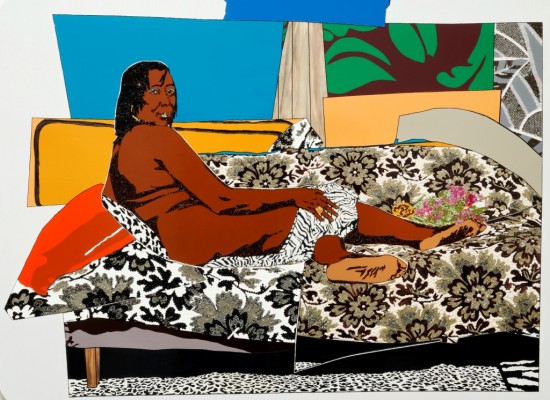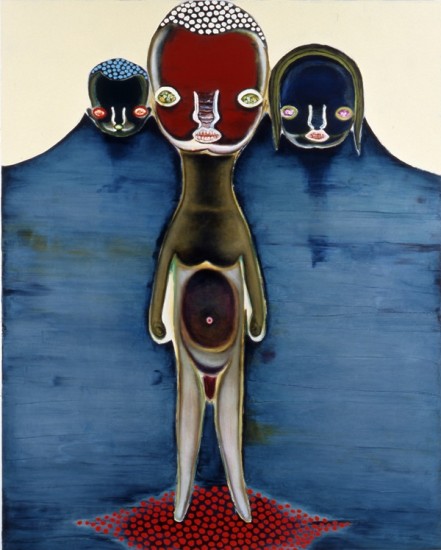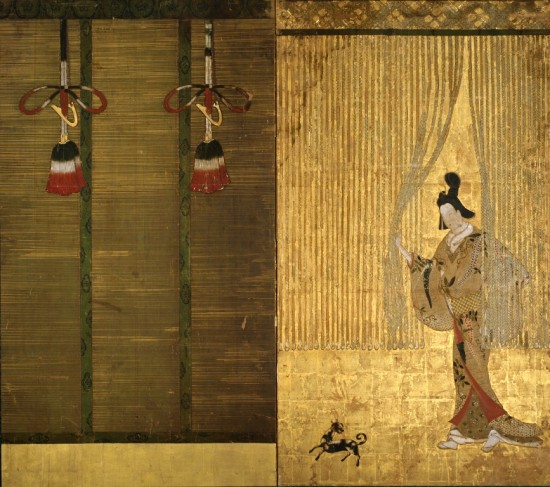◆ Body and Soul ─ Selections from the Hara Museum Collection
September 17 (Sat.), 2011 to January 4 (Wed.), 2012 Galleries A, B and C
The expression “body and soul” has had a long tradition of use in America, among other countries, appearing in countless titles of songs and movies. In Japan the expression has also become a common one that is mainly encountered in music. On display in the contemporary art galleries are works selected from the Hara Museum Collection with “body and soul” as the keyword. The body has been compared to many things; for example, a container for the soul or a shell for the spirit. Some view the body and soul as being one and the same thing, or the body as a medium through which the self interacts with others and the surrounding world. We in this media age experience the body with its expanded capabilities made possible by various tools and technologies. In some of some of the paintings, photographs, sculptures and other works on display, the body is clearly the subject; in others it is not. Nonetheless, it is hoped that their myriad expressions will inspire viewers to consider anew the connection between the body and the spirit and what the body means to them.
Featured artists: Izumi Kato/Yayoi Kusama/Ushio Shinohara/Tabaimo/Miwa Yanagi/Tomoko Yoneda/William Kentridge /Laurie Simmons/Mickalene Thomas and others (tentative)

From the left: Mickalene Thomas, Mama Bush : One of a Kind Two, 2009

Izumi Kato, Untitled, 2006
◆ Beautiful Visages– Featuring the Important Cultural Property Female passing through a reed portiere
September 17 (Sat.) – October 26 (Wed.), 2011 Kankai Pavilion
This exhibit marks the first public display of the Important Cultural Property Female passing through a reed portiere since restoration work on it was completed. As a predecessor to the many paintings of beautiful women that appeared during the Edo period, this work is a valuable example from a transitional period that led to a new representation of feminine beauty focused on a single standing figure. With this work as its centerpiece, this show presents a selection of paintings in which women are depicted, such as Jasoku’s “Reishojo (female wizard with flower basket)” and Kano Sotoku’s “Yang Guifei playing chess.” It shines a spotlight on the idea of feminine beauty and how it is expressed and represented in the various works. Joining these selections from the Hara Rokuro Collection of traditional East Asian art is one contemporary piece from the Hara Museum Collection that takes as its subject a woman of the present age. We invite you to enjoy the different expressions of women as they engage in a dialog that transcends time and place.

Female passing through a reed portiere (Important Cultural Property), two-folded screen, Edo period, 17th century
Featured works (selected):
Traditional Art: Female passing through a reed portiere (Important Cultural Property), Edo period, 17th century/Attributed to Jasoku, Reishojo, female wizard with flower basket, Muromachi period, 16th century/Kano Tan’yu, Avalokitesvara appearing from the clam, Edo period, 17th century/Kano school, Birds and flowers (part of paintings used for wallpaper and sliding doors at Nikko-in guest hall in Mi’idera temple), Momoyama-Edo period, 16th-17th century/Kano Sotoku, Yang Guifei playing chess (part of a set of twelve hanging scrolls by painters of the Kano school), Edo period, 17th century/Kano Shiro-jiro (Sadanobu), Wang Zhaojun (part of a set of twelve hanging scrolls by painters of the Kano school), Edo period, 17th century/Tier of boxes decorated with a squirrel and grape vine design in maki-e, Edo – Meiji period, 19th century
Contemporary Art: Yasumasa Morimura, Self-Portrait with Hand Mirror, 1994/Kaoru Ijima, Tamao Series, 1984-86/Marta Pan, Sculpture 93, 1965/Noe Aoki, Tateyama, 2007/Shiro Kuramata, Flower Vase #3, 1989
◆ Shapes of the Seasons
October 28 (Fri.), 2011 to January 4 (Wed.), 2012 Kankai Pavilion
Over the ages, the Japanese have cultivated a keen sensitivity towards the passage of time and the changing seasons. This exhibition invites you to enjoy the variety of ways in which this sensitivity has been manifested in art.

Maruyama Okyo, Landscape of Yodo River, hand scroll (detail), Edo period, 1765
Place: Hara Museum ARC (2855-1, Kanai, Shibukawa-shi, Gunma-ken 377-0027) Tel: 0279-24-6585
Organized by: Hara Museum of Contemporary Art
http://www.haramuseum.or.jp (official website)
http://mobile.haramuseum.or.jp (mobile site)
https://www.art-it.asia/en/u/HaraMuseum_e (blog)
http://twitter.com/#!/HaraMuseumARC (Twitter)
Hours: 9:30 am – 4:30 pm *last entry 30 minutes before closing
Closed: Thursdays during the exhibition period and January 1(open on November 3 and December 29)
*Closed temporarily in the event of severe weather.
Admission: General (over 12) 1,000 yen; children (over 3) 500 yen; 10% discount for a group of 20 or more.
**Children must be accompanied by an adult
***Combination ticket for Hara Museum ARC and Ikaho Green Bokujo ranch: General 1,800 yen; Children 900 yen
Getting There: By train: Take the Joetsu Shinkansen to Takasaki, change to the Joestu Line, and disembark at Shibukawa. From Shibukawa, ARC is 10 minutes away by taxi or 15 minutes by bus (take the Ikaho Onsen bus to “Green Bokujo Mae”). By car: 8 kilometers (about 15 minutes) from the Kan-etsu Expressway Shibukawa Ikaho Interchange (in the direction of Ikaho Onsen).
———————————-
ACCESS
By Train
By JR Joetsu・Nagano Shinkansen
Recommended timetable
・10:12 Depart Tokyo Station→11:01 Arrive at Takasaki Station/ 11:11Depart Takasaki Satation→11:35 Arrive at Shibukawa Station
・11:12 Depart Tokyo Station→12:03 Arrive at Takasaki Station/ 12:20 Depart Takasaki Satation→12:44 Arrive at Shibukawa Station
・12:24 Depart Tokyo Station→13:14 Arrive at Takasaki Station/ 13:31 Depart Takasaki Satation→13:56 Arrive at Shibukawa Station
By JR Joetsu Limited Express Kusatsu
・ 9:00 Depart Ueno Station→10:37 Arrive at Shibukawa Station (No.31 ; operates only on Saturdays, Sundays and holidays)
・10:00 Depart Ueno Station→11:43 Arrive at Shibukawa Station (No.3 ; operates only on Saturdays, Sundays and holidays)
・12:00 Depart Ueno Station→13:45 Arrive at Shibukawa Station (No. 5)
From Shibukawa Station, take the Kan-etsu Kotsu Bus and get off at the station “Green Bokujo Mae.” http://www.kan-etsu.net/r-bus/timetable/shibu-ikaho-1.htm (in Japanese only). ARC is about 7 minute walk from the bus station.
By Car
Take the Kan-etsu Expressway to Shibukawa Ikaho Interchange. Go in the direction of Ikaho Onsen for 8 km (about 15 min.) .
Highway information:
E-NEXCO Drive Plaza http://www.driveplaza.com/ (in Japanese only)
